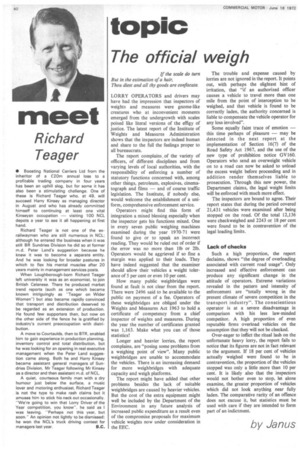topic
Page 42

If you've noticed an error in this article please click here to report it so we can fix it.
The official weigh
LT the scale do turn But in the estimation of a hair, Thou diest and all thy goods are confiscate LORRY OPERATORS and drivers may have had the impression that inspectors of weights and measures were gnome-like creatures who at inconvenient moments emerged from the undergrowth with scales poised like literal versions of the effigy of justice. The latest report of the Institute of Weights and Measures Administration shows that the inspectors are indeed human and share to the full the feelings proper to all bureaucrats.
The report complains, of the variety of officers, of different disciplines and from varying levels of local authorities, with the responsibility of enforcing a number of statutory functions concerned with, among other things, petroleum, explosives, cinematograph and films — and of course traffic legislation. The Institute, if nobody else, would welcome the establishment of a uniform, comprehensive enforcement service.
Operators might find this form of integration a mixed blessing especially when the inspector gets his functions mixed. One in every seven public weighing machines examined during the year 1970-71 were found to give or to speak an incorrect reading. They would be ruled out of order if the error was no more than lib or 21b. Operators would be aggrieved if so fine a margin was applied to their loads. They have indeed suggested that the examiner should allow their vehicles a weight tolerance of 5 per cent or even 10 per cent.
How many public weighbridges were found at fault is not clear from the report. There were 2496 said to be available to the public on payment of a fee. Operators of these weighbridges are obliged under the Weights and Measures Act 1963 to hold a certificate of competency from a chief inspector of weights and measures. During the year the number of certificates granted was 1,163. Make what you can of those statistics!
Longer and heavier lorries, the report complains, are "posing some problems from a weighing point of view". Many public weighbridges are unable to accommodate the vehicles. There is an increasing demand for more weighbridges with adequate capacity and weigh platforms.
The report might have added that other problems besides the lack of suitable weighbridges are caused by heavier vehicles. But the cost of the extra equipment might well be included by the Department of the Environment in any future analysis of increased public expenditure as a result even of the compromise proposals for maximum vehicle weights now under consideration in the EEC. The trouble and expense caused by lorries are not ignored in the report. It points out, with perhaps the slightest hint of irritation, that "if an authorized officer causes a vehicle to travel more than one mile from the point of interception to be weighed, and that vehicle is found to be correctly laden, the authority concerned is liable to compensate the vehicle operator for any loss involved".
Some equally faint trace of emotion — this time perhaps of pleasure — may be detected in the next report at the implementation of Section 16(7) of the Road Safety Act 1967, and the use of the new type of prohibition notice GV160. Operators who send an overweight vehicle on to a road can now be asked to unload the excess weight before proceeding and in addition render themselves liable to prosecution. Through this new power, the Department claims, the legal weight limits will be enforced with much more effect.
The inspectors are bound to agree. Their report states that during the period covered 21,431 vehicles were examined after being stopped on the road. Of the total 12,136 were checkweighed and 2243 or 18 per cent were found to be in contravention of the legal loading limits.
Lack of checks Such a high proportion, the report declaims, shows "the degree of overloading associated with current road usage". Only increased and effective enforcement can produce any significant change in the attitude of operators. Extreme variations revealed in the pattern and intensity of enforcement are "totally wrong in the present climate of severe competition in the transport industry". The conscientious operator is at a severe disadvantage in comparison with his less law-minded competitor. A high proportion of even reputable firms overload vehicles on the assumption that they will not be checked.
Over-eager to inflict the ritual lash on the unfortunate heavy lorry, the report fails to notice that its figures are not in fact relevant to the argument. If 18 per cent of vehicles actually weighed were found to be in contravention, the proportion of the vehicles stopped was only a little more than 10 per cent. It is likely also that the inspectors would not bother even to stop, let alone examine, the greater proportion of vehicles which did not look anything near fully laden. The comparative rarity of an offence does not excuse it, but statistics must be used with care if they are intended to form part of an indictment.
by Janus




























































































